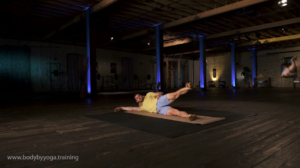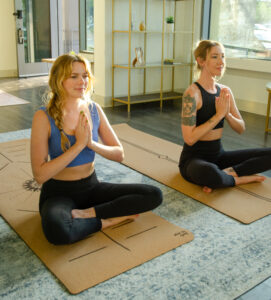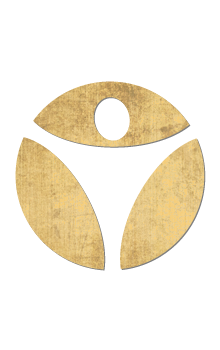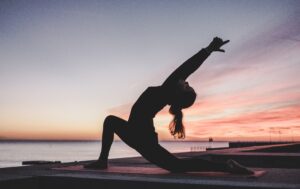Why Gentle Beginner’s Yoga is Great for Older Adults
- Updated on: December 27, 2021
Gentle Yoga

Yoga is for everyone. There is no specific age group or experience level necessary to find your own yoga practice. There are many different types of yoga that a person can try, and this makes it much easier to find the practice that is best for you!
Remember, yoga is for all. Even if you are a beginner who has never practiced it before, that does not mean you cannot start now. When it comes to yoga for an older population, there are a variety of practices to choose from. However, gentle yoga is definitely a great place to start out, especially if you do not have prior experience with yoga. Gentle yoga is also great for all levels and there are many different types of gentle yoga to try!
Definition of Gentle Yoga
This raises the question, what is gentle yoga?
Gentle yoga is exactly what it sounds like; it is simply a gentler yoga practice. You won’t find super intense balancing poses in gentle yoga. This makes it a great class for beginners. Gentle yoga also encourages students to take their time, as they should in any class, to experience each individual pose and to move at their own pace. Gentle yoga will also be a slower practice, giving you a chance to move through the poses and discover how they feel for you. This is great for learning about your own body and discovering your level of flexibility.
Did you know that yoga is not about being as flexible as possible? That’s right. Yoga focuses on your level of flexibility and working within it. Yoga is a self-study, and no matter what your prior knowledge is of the practice, when you do yoga, you can learn more about yourself. This enforces a connection of mind and body.
In general, a gentle yoga practice will typically begin to open up the fascia, or the tissue that sits between the muscles, organs, blood vessels, and bones.
Why do Older Adults Need Yoga?
Everybody can benefit from yoga, but what most don’t realize is that the older you are, the more you can gain from the practice. Yoga can actually promote healthy aging.
As we age, if we are not stretching, the fascia can begin to lock up and get hard. This can cause discomfort and soreness, which many mistake as pulled muscles. However, the good news is that tight fascia can be reversed.
In addition to the fascia locking up, as we grow older, many develop a rounded back. This spinal curve is unwanted and can cause a lot of discomfort. Many people sit around a lot at desks for work or hunch over while driving. Over the years, this can lead to a rounded back. This is known as kyphosis and can also cause back pain. Yoga can actually decrease this curve in the spine, easing discomfort. It can even correct posture!
The great thing about yoga is that the practice will vary person to person, allowing you to work on the needed ailments. When going into a new practice, if you have any medical conditions, tell your teacher ahead of time so that you can be given alternate poses to do instead. This allows everyone to experience the practice that they individually need.
As we age, many ailments can begin to make themselves known to us. Besides fascia and rounded backs, aging can also cause ongoing neck and shoulder pain, high blood pressure, stiffness in the joints, a build-up of unwanted toxins in the lymph nodes, arthritis, osteoporosis, carpal tunnel syndrome, and so much more!

Gentle Yoga for Seniors
Gentle yoga is a great way to work on these ailments, and in addition to physical relief, gentle yoga also helps to decrease stress, anxiety, depression, and many other mental problems as well.
Breathing techniques are very helpful in particular for helping to calm anxiety and stress. In addition, breath-work stimulates the lungs and the nervous system, helping to relax the nervous system and open up the lungs. If you struggle from asthma or similar breathing difficulties, breath work in yoga can definitely be helpful for you!
However, always make sure to let your teacher know ahead of time if you do have any ailments with the lungs so they can adjust the breath work you are doing and keep an eye on you.
As we grow older, our blood oxygen levels can decrease, and breath work can strengthen these levels, distributing oxygen throughout the body, and making breathing easier in general.
In addition, we lose muscle strength and our balance often decreases as the years go by. Yoga is a great way to help balance and increase strength in the muscles, making it easier to move around and feel safe and secure while doing so.
Yoga also promotes mindfulness which is something everybody can work on, no matter the age. Mindfulness is all about bringing your attention to the here and now without focusing on the past or worrying about the future. The present is all we have, and we must do our best to find joy and peace within every moment without worrying about what comes next or what has already happened.
Types of Gentle Yoga
Did you know that there are multiple types of gentle yoga? We will take a look at some of these and break down the differences of each one, allowing you to choose which one would be best for you! Keep in mind that these are only some of the many gentle yoga practices out there, and we are simply looking at the most common ones that are best for older yogis just starting out.
- Restorative Yoga– One of the most common gentle yoga practices is restorative yoga. This practice involves doing multiple poses directly on the mat. Each pose is held for at least a few minutes to really experience the stretch and open up the muscles. Students are encouraged to take their time coming into the poses, and once they reach the edge of the pose where they can feel the deepest stretch, students will then hold the pose and experience the benefits. Here, some can even feel the gentle opening of the fascia and draining of the lymph nodes. This is a very gentle and relaxed practice that is meant primarily for relaxation and stress-relief while still giving physical benefits as well. If you are healing from injuries but still able to move around, restorative might be a good option for you. Restorative yoga often offers props as well to support you wherever you are on your journey. This is great for those who enjoy doing poses on the mat, but if you have trouble getting up and down on the mat easily, or if you have any knee injuries, this practice might be too intense for you.
- Yin Yoga- This practice is very similar to restorative yoga. The main difference is the intensity of the poses on the mat and how deep into the poses students are guided. In yin yoga, the poses might be held longer, relaxing and balancing the nervous system. While restorative yoga is great for relaxation and healing after injuries, yin yoga is wonderful for really getting into the connective tissues of the body and opening them up. While both practices are great for releasing and stretching the fascia, Yin is more intense and will promote deeper stretches. Like restorative yoga, yin yoga will often offer props as well. In addition, once again, if you suffer from any knee injuries or have trouble getting up and down on the mat, this might not be the practice for you.
- Gentle Hatha Yoga- For those with more mobility, a gentle, beginner’s hatha yoga practice might be the right choice. Hatha yoga is an umbrella term that encompasses the majority of yoga flow practices. Any class that is labeled gentle or for beginners can be great for new yogis, but do your research first. In addition, make sure to always talk to your teacher before hand to let them know of whether or not you have a prior practice, and what, if any, ailments you have. If mobility and getting up and down on the mat is difficult for you, you should avoid this kind of practice.
- Chair yoga– This is arguably the most common form of yoga for seniors who are just beginning their practice. By having a chair to sit in, stretches are much easier to do, and you might find you can get even deeper into the poses by having this support. If standing poses are involved, the chair will be used to support you and your balance. This is a wonderful place to start a practice and build up endurance over time. In addition, if you have any past knee injuries or trouble getting up and down on the mat, this is the practice you will most likely want to try. Meditation can also be done from your chair as well if need be.
How to Know if Your Class Will be Gentle?
Yoga classes will be labeled based on what type of class you would be offered. If a class is labeled as ‘gentle yoga’ or ‘beginner’s yoga’ then that is a good sign that you will have a gentle practice. In addition, you can check whether the class is restorative or yin, and you can look for a chair yoga class if needed.
If you still aren’t sure whether a class is right for you, feel free to call up the studio offering it and ask any questions you have to learn more about what you will be doing. Then, if and when you do go to the class, ask the teacher directly and explain both your past experience, if any, and what ailments you have. It is always a good idea to talk to your yoga instructor, and a good teacher will be more than happy to both answer your questions and help you out. If alternative poses are needed, they will be offered to you.
Modifying Poses to Make Them More Gentle
Most poses can be modified to be more gentle and easier to do. While you can always ask your yoga teacher for alternative options, there are also many very gentle practices you can do at home. All balancing poses can be done while holding onto the chair or a wall, but these poses are not recommended to try for the first time without a teacher present.
Many poses can be made easier with simple adjustments or alternative options. Using props, such as blocks and straps, can be very helpful when doing poses to make sure you don’t overextend. In addition, chair yoga poses are simply different versions of regular yoga poses. There are always modifications for every pose, so make sure to find out what your options are and go at your own pace. You can learn more about blocks and props on our website as well!
Here are a few examples of some modified yoga poses:
- Warrior I- Warrior I is a great standing pose with many benefits for strengthening the legs and core, but did you know you can do this pose using a chair for support? Whether you hold onto the chair to stabilize you, or if you are sitting in the chair to hold you up, you can try this pose safely at home. If you are holding onto the chair for support, step one foot out in front of you, and the other leg behind you, dropping the back foot at a 45 degree angle. Bend into the right knee, keeping your hand on the chair for support. Keep the hips squared. If you are choosing to try this sitting down, bring the legs out to the side and turn one foot in and the other out. Bend into the knee of the foot facing out and maybe even bring one hand up. Hold for a few breaths, and then switch sides. Need some guidance? Click here!
- Forward Fold- A forward fold is a great way to drain the lymph nodes and give a gentle inversion. If you have high blood pressure, this might not be the best pose for you. If you want to try this pose, but need a slight modification, you can use a block here to support you. Steps the feet hip-width distance apart and place a block long-ways up in front of you. As you fold forward, bring both hands to the block for support. Hold here for a few breaths and then carefully come back up, never rushing. Need some guidance for trying this pose? Click here!
Yoga From Home and Yoga Videos
If you are unable to go to a class in person, there are many options online for you to try at home. There are a ton of youtube videos out there, and a lot of teachers actually specialize in senior yoga.
We offer our own Body by Yoga youtube videos. Just click here to check them out. We even offer specific senior yoga videos. For example, here is a chair yoga tutorial for shoulder mobility. You can also click here to try a one minute chair yoga practice for keeping a healthy spine. These are only a few of the many practices we offer.
It might take some time to find your favorite video and teacher, but that is all part of the fun. Just be careful and make sure to take your time. If you rush into and/or force poses, you may accidentally do something unsafe that your body is unable to do. This can cause injuries and unwanted strain on the body.
Listening to your body is key in whatever practice you do.
Did you know we offer some awesome yoga trainings? You can check out our yoga fix training here which is aimed for absolute beginners.
You can also check out our yoga vitality training for healthy aging here!
Studies and Statistics
Many studies have been done to test the effectiveness of gentle yoga with a senior population. One pilot study proved that yoga is indeed safe for seniors to do, though some modifications might be needed. Though a control group was not present for this study, the test subjects involved were able to keep up with the practice. (Galantino, M. L, et. al)
Ongoing yoga practices can definitely help with many ailments and conditions. In many cases, students are able to build up muscle strength and balance through a continuous practice, making it easier and possible to keep up with yoga overtime.
Another study compared the results of seniors who tried gentle yoga to the results of a control group. The study found that the yoga group has increased flexibility, balance, and strength in the lower limbs while also decreasing depression and stress. In addition, many students were also sleeping better and deeper which is so important for one’s health. These were only some of the many results found, but overall, students had more balance in many areas of their everyday lives. (Sivaramakrishnan, D, et. al)
Another study presented a ten-week program where older students would receive yoga. This study in particular focused on seniors who were mostly inactive throughout the day. Compared to a control group, the data found that the majority of the students receiving yoga had somewhat better balance and mobility by the end of the study. It also proved that yoga can help with both physical and mental wellness for inactive seniors. (Tew, G.A., et. al)

Gentle Chair Yoga Poses to Try at Home
There are many different chair yoga poses to try at home, but we will look at some of the more gentle ones that are safer to try yourself. As always, be careful with each pose, and if there is something you cannot do due to anything medical, please avoid that specific pose. Always listen to what your doctor says first and foremost.
- Easy Seated Twist- Sit in a chair with both feet flat on the ground. As you inhale, bring your arms out in front of you, and as you exhale, twist gently to one side, reaching for the outside of your thigh, or to the outside of the chair. Never force the twist. Just gently breathe into it. Inhale to come back to center when you are ready, and exhale to turn to the opposite side.
- Seated Cat/Cow- This is one of the easiest seated stretches to do and is great for the back. Simply rest your hands on your thighs and as you inhale, look up to the sky and arch your back into cow pose. As you exhale, round your back and gently tuck your chin to your chest, coming into cat pose.
- Gentle Neck Rolls- Start by sitting up nice and tall. As you inhale, bring your head up and around on the neck, and as you exhale, bring your head down and around. Continue this slowly, working with the breath, and going at your own pace. Do this for multiple breaths, and then switch directions. Do the same amount of neck rolls moving in this direction now. When finished, come back to center on the inhale, and notice how you are feeling with the exhale.
- Gentle Shoulder Rolls- Inhale and squeeze your shoulders up to your ears. Exhale and roll them back down. Repeat this for about five breaths or however long you would like. Allow the shoulders to move slowly up and down, keeping the muscles engaged. This is a great stretch for the shoulders and helps decrease shoulder pain.
Try Gentle Yoga Today
No matter how old you are or what your prior practice is, yoga is for you. There are many types of yoga practices, and if one is too difficult for you to do, there are other ones to try. The best part is that there are multiple gentle practices to pick from, so you can try different ones out and find out what works best for you. You may discover a new favorite practice!
If you are ever unsure about certain poses, please ask your yoga instructor. If you need to use props then do so. If you need alternative poses, there are always many options.
Yoga has so many wonderful benefits and can improve a variety of ailments and conditions. That being said, if you are unsure, you can check with your doctor and ask what is safe to be doing.
Find your practice and show yourself some love by trying out a gentle yoga practice. You deserve it!
Citations: Galantino, M. L., Green, L., Decesari, J. A., Mackain, N. A., Rinaldi, S. M., Stevens, M. E., Wurst, V. R., Marsico, R., Nell, M., & Mao, J. J. (2012). Safety and feasibility of modified chair-yoga on functional outcome among elderly at risk for falls. International journal of yoga, 5(2), 146–150. https://doi.org/10.4103/0973-6131.98242 Sivaramakrishnan, D., Fitzsimons, C., Kelly, P. et al. The effects of yoga compared to active and inactive controls on physical function and health related quality of life in older adults- systematic review and meta-analysis of randomised controlled trials. Int J Behav Nutr Phys Act 16, 33 (2019). https://doi.org/10.1186/s12966-019-0789-2 Tew, G.A., Howsam, J., Hardy, M. et al. Adapted yoga to improve physical function and health-related quality of life in physically-inactive older adults: a randomised controlled pilot trial. BMC Geriatr 17, 131 (2017). https://doi.org/10.1186/s12877-017-0520-6
Related Articles

Stretching and Strengthening your hips
In this workout we start slow to warm up your hips. Utilizing low impact workouts like this can be important for beginners and yoga veterans

Hatha vs Power yoga
We’ve created our own unique style of slow burn power yoga that combines Hatha yoga, power yoga, bodyweight exercises and physical therapy. This way in

The importance of maintaining correct alignment
Everything in your body is connected, so when one muscle isnt aligned properly it can be a slippery slope to injury. Building a solid foundation

